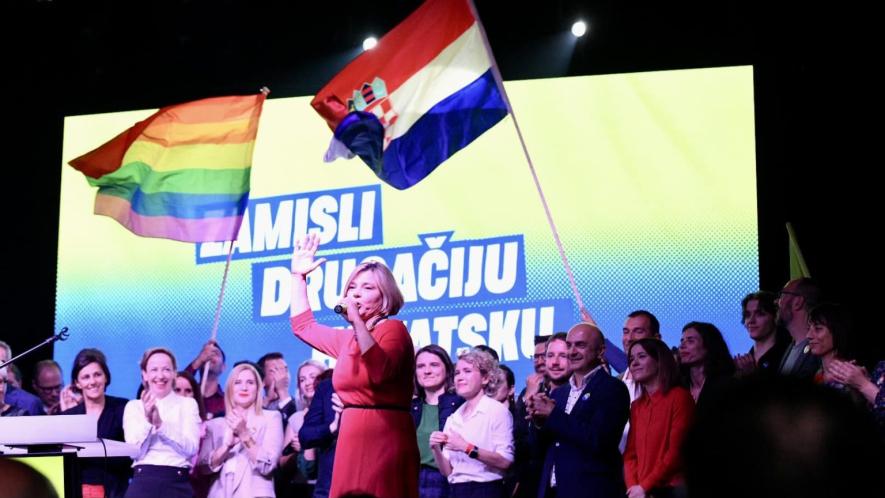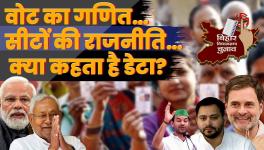Croatian Democratic Union Secures Most Mandates in Parliamentary Elections

Sandra Benčić (Možemo!/Greens) addressing supporters during the night of the parliamentary elections on April 17, 2024.
In March 2024, Croatian president Zoran Milanović announced the date for parliamentary elections, the first of three electoral processes to take place this year. Speaking at a press conference on the same day, Milanović said that “waves of justice” were coming for the government led by Andrej Plenković of the Croatian Democratic Union (Hrvatska demokratska zajednica, HDZ), which had been marked over the past eight years by scandals and allegations of corruption. What Milanović expected to be waves, however, turned out to be ripples: on April 17, HDZ secured the most votes, winning 61 mandates.
This marks the third consecutive time that HDZ has emerged as the relative winner of the parliamentary elections, followed by a coalition led by the Social Democratic Party of Croatia (Socijaldemokratska partija Hrvatske, SDP), which won 42 mandates, and the far-right Homeland Movement (Domovinski pokret, DP), which secured 14 seats in parliament. Next in line are another conservative option, Most, and the green platform Možemo!, which won 11 and 10 mandates, respectively.
On April 17, many voters came to the polls and found out that they were missing from the official registers. The National Electoral Commission attributed this to an error in the registration system, but opposition parties and voters alike called this out as a potential attempt of manipulation.
Overall, the outcomes of the election are hardly surprising, considering HDZ’s dominance in parliamentary politics since the early 1990s and the widespread network of dependents it has all over the country. Opposition parties attributed HDZ’s previous electoral victories to this clientelistic network: in combination with traditionally low voter turnout, the party was able to capitalize on its many dependents to win the votes necessary, the opposition reasoned. In the most recent election, therefore, one of the most significant strategies of the opposition was to ensure that as many people as possible came to the polls.
On election day, the turnout was indeed what the opposition parties were hoping to achieve, amounting to 62.3%—a significant improvement since 2020, when it fell below 50%. Yet the results did not meet the expectations of the social democrats and the greens, indicating that there might be more to HDZ’s electoral victories than voters’ lethargy.
However, the results are not simply an outcome of a gross underestimation of HDZ’s mobilization capacities. They are also related to the current electoral system, which is shaped to benefit the same party. The country is currently divided into 10 electoral districts that do not reflect the standard boundaries of geographic or administrative regions—but ensure that places which usually vote for parties other than HDZ are merged with those with a strong HDZ presence, impacting the final results.
For example, if one looks at the total number of votes received by the social democrats and the greens on the national level, one finds that, together, they received more votes than HDZ—721,500 compared to 697,800. Yet, combined, they barely match HDZ’s number of mandates in the parliament. This discrepancy occurred because of the distribution of the votes, where SDP and Možemo! secured a disproportionate number of votes in specific units, which could not be translated into mandates, while HDZ’s numbers were more evenly distributed across electoral districts.
A second apparently misguided belief of some opposition factions was that the figure of the current president, Zoran Milanović, would be a unifying factor against HDZ. Since his election in 2019, Milanović has built up his public persona in confrontation with HDZ’s prime minister, Andrej Plenković. This approach brought him more popularity, yet also made him a controversial figure due to misogynistic comments and use of right-wing vocabulary. Shortly after he called for the election, Milanović also announced that he would be SDP’s candidate for prime minister, without giving up his presidential post in the meantime. This move, obviously relying on a significant shock factor, added uncertainty to the parliamentary election campaign, with most still uncertain about what it would mean to have a president who is also about to become prime minister.
Three scenarios for a future government
The day after the election, another HDZ-led government seems to be the most plausible scenario, but the party will have to secure the support of another 15 parliamentarians to ensure a majority. In order to do that, they have two main options: entering a partnership with the Homeland Movement and/or Most; or securing support from delegates of a wider array of parties, who traditionally switch camps after the election. The latter option would be more unstable, but it would also entail fewer compromises for HDZ than the partnership with the Homeland Movement. In the other case, the content of the policies would almost certainly shift further to the right, encompassing the xenophobic and ethnic slurs that mark the Homeland Movement’s program and appearances.
A third option, which at the moment seems unlikely, but is still addressed by SDP and other center-to-left opposition parties, is the formation of a minority government by SDP, supported in parliament by all other options—center, right, and green. In that case, the unifying factor as described by Sandra Benčić from Možemo! would simply be keeping HDZ out of power. What that would mean for the content of the laws and policies, or the credibility of the Greens in the eyes of their own electorate, remains unspecified at this time.
Recalling SDP’s last stint in power in 2011-2016, it shouldn’t be taken for granted that such a minority government would bring significantly different content from HDZ. During that period—with Milanović as prime minister of the country—the SDP administration promoted a number of moves against the public and workers’ interests. This included the intention to sell off the national highways company, only stopped by a campaign in which many of Možemo!’s activists played an important role. It was also marked by disrupted communication with trade unions, with some trade unionists defining Milanović’s government as “the worst ever” when it comes to collaboration with workers’ organizations, not outdone even by HDZ.
In the short term, it appears that it will be impossible to avoid a further shift to the right or compromises that will mark the credibility of parties left to HDZ as the new government is formed. In the long term, it remains clear that the opposition must put much more effort into building its presence outside of large cities, seriously taking into account the needs of the working class and agricultural workers. In light of this, the most notable loss in this election might be that the only socialist parliamentary option, Workers’ Front (Radnička fronta), lost the seat it was holding throughout the past term. Without their presence in parliament, it is likely that reactions to the policies introduced by a new HDZ government will not include an explicit anti-capitalist stance.
Get the latest reports & analysis with people's perspective on Protests, movements & deep analytical videos, discussions of the current affairs in your Telegram app. Subscribe to NewsClick's Telegram channel & get Real-Time updates on stories, as they get published on our website.















